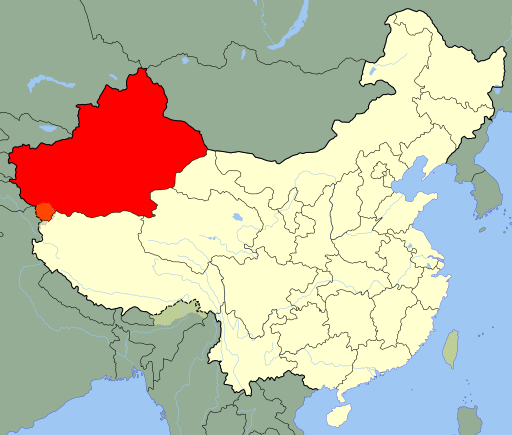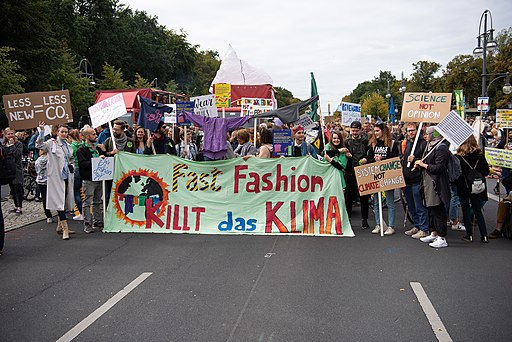Keeonb2012, CC BY-SA 3.0, via Wikimedia Commons
What Is Slow Fashion, And Why Does It Matter?
Slow fashion refers to a popular trend in the industry that promotes a more equitable way of production, ranging from ethically-sourced materials to eco-friendly shipping standards.
Slow fashion has become one of the industry’s buzziest terms of late. But with few clear standards around what the trend actually means–and what it doesn’t–it’s often used as a marketing tool rather than championing more equitable business practices.
It’s something of a reaction to the mainstream fashion industry’s demand for low-cost garments at scale.
It’s also a critique of capitalism more broadly, this time honing in on how your favorite shirts, coats, and socks are manufactured.
It’s for this reason that it often gets grouped in with environmentalist language as well as more progressive economic models.
It’s both a form of self-preservation and a way of doing business.
So, what is slow fashion, and why does it matter?
 Andy Mabbett, CC BY-SA 3.0, via Wikimedia Commons
Andy Mabbett, CC BY-SA 3.0, via Wikimedia Commons
What Slow Fashion Isn’t
The ability to sell low-priced garments at scale around the world isn’t, with few exceptions, slow fashion.
Fashion brands that are able to execute this kind of business model are cutting corners somewhere, it’s simply a matter of finding them.
They could be using harmful dyes in their polo shirts, for example, tapping cheap labor to make shoes, or one of its suppliers may be inappropriately disposing of any wastes.
Let’s take a quick look at a few examples.
In an investigation conducted in 2021 by the CBC, investigators discovered that products purchased from fast-fashion brands Shein, AliExpress, and Zaful allegedly contained potentially toxic chemicals.
These substances reportedly included phthalates, PFAS, and lead. In one instance, the investigators found that a toddler’s jacket contained 20 times the allowable amount of lead per Health Canada’s legal standard.

Hanna Joerss and Frank Menger (Department for Organic Environmental Chemistry, Helmholtz-Zentrum Hereon, Max-Planck-Str. 1, 21502 Geesthacht, Germany), CC BY-SA 4.0, via Wikimedia Commons
High exposure to lead can lead to brain and kidney damage, and PFAS (polyfluoroalkyl substances) has been shown to contribute to an increased risk of thyroid damage and asthma.
Both of these chemicals are often used to dye fabrics, too; even though safer, albeit more expensive, alternatives exist.
If it’s not toxic chemicals, it’s exploitative labor. One of the greatest stains on the fashion industry has been that of sourcing huge amounts of cotton from the Xinjiang region in China.
Various reports indicate that cotton harvested in this area is via the alleged coerced labor of the Uyghur people. Human rights groups around the world have accused China of crimes against humanity for detaining and emprisoning the Uyghur people in so-called reeducation camps.
Critically, materials sourced from this area and this labor has played a key role in servicing materials for key fast fashion brands like Nike and H&M.

Xinjiang region in China. Source: Wikimedia Commons.
“Under conditions that strongly suggest forced labor, Uyghurs are working in factories that are in the supply chains of at least 82 well-known global brands in the technology, clothing, and automotive sector,” read a March 2020 report from the Australian Strategic Policy Institute.
Many of these brands have updated their policies, distancing themselves from any known exposure to forced labor, but full transparency on the matter has been less than convincing.
Nike reportedly admitted that “traceability at the raw materials level is an area of ongoing focus,” suggesting that the Fortune 500 sportswear brand is still working on it.
 Unknown (artist), Multi Machine Plates Ltd, London EC4 (printer), Her Majesty’s Stationery Office (publisher/sponsor), Public domain, via Wikimedia Commons
Unknown (artist), Multi Machine Plates Ltd, London EC4 (printer), Her Majesty’s Stationery Office (publisher/sponsor), Public domain, via Wikimedia Commons
Finally, the fashion industry as it stands today is a huge consumer of water and a huge generator of waste. One need only look to Chile’s Atacama Desert, and arid plateau that has become something of a dumping ground for fast fashion.
A report from Aljazeera in 2021 indicated that of the 59,000 tonnes of clothing that arrives in Chile each year, more than 60% of that ends up in the Atacama. Worse yet, due to the harmful chemicals present in many of these materials, they can’t be thrown away in landfills, explained the founder of Ecofibra. Ecofibra turns many of these clothes into insulation to help combat the problem.
Still, the source of the problem lies elsewhere, especially when one considers that the average garment is only worn seven times before its discarded.
Solving these problems at the source is, in essence, the thrust of the slow fashion movement.
 Stefan Müller (climate stuff), CC BY 2.0, via Wikimedia Commons
Stefan Müller (climate stuff), CC BY 2.0, via Wikimedia Commons
What is slow fashion?
Slow fashion can be boiled down to a few key tenets: Local, sustainable, and transparent.
Buying materials, either as a designer or a consumer, locally means you’re cutting out extensive supply chains that may see products intermingled with producers that aren’t following best practices. This is especially the case when dealing with much larger production sizes.
This also means you know precisely where your clothes are coming from, making it easier to make informed decisions about what you’re buying.
Sustainable means that the products going into a garment aren’t especially harmful to the environment. Inevitably your favorite jacket from university gets worn out and irreparable damaged. But that shouldn’t mean it can’t be disposed of appropriately.
And finally, slow fashion is all about transparency. This is usually the easy part.
If suppliers are local and they’re using sustainable manufacturing practices, it should be simple to understand how they’re sourcing their materials. Unlike the sprawling supply chains of Nike and H&M–firms who aren’t even certain whether their garments are using exploitative labor–small brands and local designers likely know everyone sourcing their materials personally.
That’s slow fashion, really. A means of producing beautiful garments at human scale.




